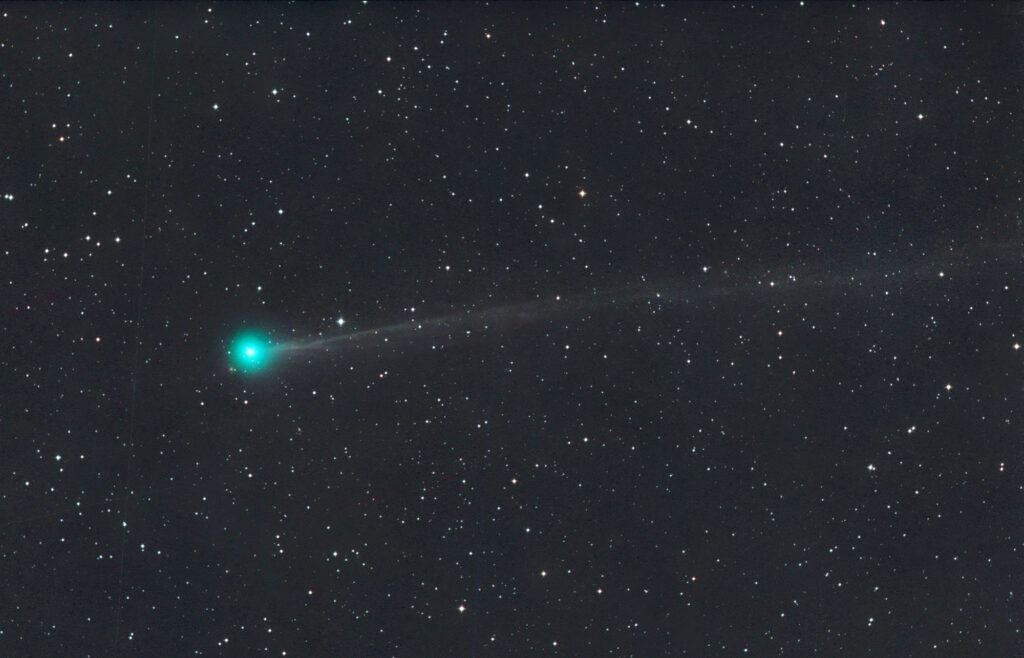On August 11, 2023, Japanese amateur astronomer Hideo Nishimura discovered a comet with the naked eye from his home in California, United States. The comet, which was called C/2023 P1 Nishimura, has been the first kite discovered in 2023.
It is a long period comet, which means that it takes many years to complete an orbit around the Sun. It is estimated that its orbit lasts about 10,000 years. The kite was formed in the Oort cloud, a spherical cloud of icy bodies surrounding the solar system.
Nishimura is an active kite, which means that it is releasing gases and dust as it approaches the sun. These gases and dust form a comma, a bright cloud that surrounds the code core. The comet comma is very large, with a diameter of about 100,000 kilometers.

This kite also has a huge tail, a cloud of gas and dust that extends behind the code core, its length is approximately several million kilometers.
The comet Nishimura will begin to be visible on September 7. It will have its point closest to the Sun, known as perihelio, on the 17th. That will make it look much brighter, but also that it is the worst time to see it, since, precisely because of the proximity to the sun, its own brightness will be camouflaged by that of the star King and we will not be able to detect it well. At that time, it will be about 12 million kilometers from the Sun, and from that moment on our star King will begin to return to our solar system in about 10,000 years, as we have mentioned above.
The best days to see it from Spain will preferably two. The first will be on September 8, since it will be when the Magnitude 4.9, which makes it visible to the naked eye. The apparent and absolute magnitude of the stars are used to know their brightness. On the one hand, the apparent gives us its real brightness, as we see it, while the absolute indicates what brightness it would have if it was at a very specific distance from the earth, of about 32 light years (10 parsecs). Thus, the brightness of many stars can be compared, even if they are at very different distances. For example, the sun has an apparent magnitude of -26.74, which indicates that it is very bright (the lower the, brighter value). However, its absolute magnitude is much greater, from +4,83. Therefore, if we see it so bright, it is because it is very close.
The second day you can see very well will be tomorrow, on September 12 , it will be another good time to see the kite, since it will be closer to the earth. That day it will be enough to look at the hours near dawn towards Leo's constellation . If you don't know how to find it, we recommend the use of applications such as Star Walk 2 or Stellarium . Being a relatively bright kite, with a magnitude of about 4.8, it will be visible to the naked eye in dark skies being able to observe it better with prismatic.
Best known comets
Comets are fascinating objects that give us information about the origin and evolution of our solar system. The following comets have been observed by the human being since ancient times.
- Halley: Comet Halley is a short period comet, which means that it takes about 76 years to complete an orbit around the Sun. The Halley kite was last seen in 1986 and will return to our solar system in 2061.
- Hyakutake: Hyakutake comet was a long -term kite that was discovered in 1996. Comet Hyakutoke was very bright and was visible to the naked eye worldwide.
- Hale-Bopp: The Hale-Bopp comet was a long period comet that was discovered in 1995. Comet Hale-Bopp was also very brilliant and was visible to the naked eye for several months.
- ISON: The comet ison was a long period comet that was discovered in 2012. The comet ison disintegrated when he approached the Sun in 2013.
- NEOWISE: The Neowise kite was a long period comet that was discovered in 2020. The Neowise comet was very bright and was visible to the naked eye worldwide.



























